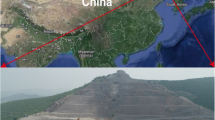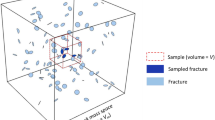Abstract
Fractures have significant impact on the stability of underground projects such as coal mining. The identification of geological features based on drilling parameters is a promising option for intelligent detection of rock formations. A series of studies conducted to identify fractures under unstable drilling conditions are presented in this paper. First, the forces acting around the drill bit are analyzed to further improve the force model of the two-wing PDC drill bit. Then, based on the self-developed borehole drilling device, the drilling parameters are collected in real time while drilling in concrete of different strengths and different fracture widths. Finally, the response characteristics of drilling parameters are analyzed, and the multi-parameter voting method is proposed for fracture identification. The experimental results show that when fracture width increases, the crushing area, which forms around the borehole when the drill bit encounters the fracture, tends to increase. The rate of penetration (ROP) increases suddenly, the revolution per minute (RPM) decreases, and the torque increases at fracture encounter. The sudden changes are recovered after passing the fracture. The multi-parameter voting method has a high recognition rate for fractures of width greater than 2 mm, but a relatively low recognition rate for fractures of 1 mm width. In addition to detecting fractures, the method performs well in predicting fracture location and fracture width.
Highlights
-
The response characteristics of multiple drilling parameters at the fracture were analyzed.
-
As the thrust (torque) increases, the amount of change in penetration rate caused by the unit change in thrust (torque) decreases.
-
Results show that the proposed multi-parameter voting method has a high recognition rate for fractures with width greater than 2 mm.

















Similar content being viewed by others
Data availability statement
The data are available from the corresponding author on reasonable request.
Abbreviations
- F :
-
Thrust
- T :
-
Torque
- α :
-
The angle between the shear surface of the chipped rock and the horizontal direction
- γ :
-
The angle between the diamond composite sheet and the vertical direction
- F f :
-
The friction between the rock and the top of the bit
- F v :
-
The reaction force on the top of the bit
- F s :
-
The cutting force generated by rotation
- P 1 :
-
The shear force and positive pressure on the shear surface of the chipped rock
- μ :
-
The coefficient of friction between the drill bit and the rock
- F n :
-
The reaction force on the chipped rock
- F 1 :
-
The shear force on the shear surface of the chipped rock
- F 2 :
-
The force on one of the lateral sides of the chipped rock
- R :
-
The borehole radius
- y(t i):
-
The actual sampling point
- D(t m):
-
The drilling parameter index
- t Tq :
-
The midpoint of the time period corresponding to the abnormal torque signal
- Y(t m):
-
The data point on the smoothed curve
- u u :
-
The upper limit
- σ :
-
The square deviation of the sample data
- V :
-
The rate of penetration
- N :
-
The revolution per minute
- β :
-
The angle between the diamond composite sheet and the P
- P :
-
The force of the cutting tooth on the chipped rock
- σ 0 :
-
The stress when the drill bit intrudes into the rock
- φ :
-
The internal friction angle
- c :
-
Cohesion
- \(S^{\prime}\) :
-
The contact area with the rock when the cutting tooth intrudes into the rock
- S 1 :
-
The area of the shear surface of the chipped rock
- g(t m):
-
The data point on the estimated trend line
- S 2 :
-
The area of the lateral surface of the chipped rock
- t Vi :
-
The midpoint of the time period corresponding to the abnormal ROP signal
- S i :
-
The displacement at the moment ti
- V i :
-
The rate of penetration at the moment ti
- λ :
-
The smoothing parameter
- t Np :
-
The midpoint of the time period corresponding to the abnormal RPM signal
- u l :
-
The lower limit
- u 0 :
-
The mean value of the sample data
- λ 0 :
-
The coefficient term
References
Bahrampour S, Rostami J, Ray A, Naeimipour A, Collins C (2015) Ground characterization and roof mapping: Online sensor signal-based change detection. Int J Min Sci Technol 25:905–913. https://doi.org/10.1016/j.ijmst.2015.09.005
Basarir H, Karpuz C (2016) Preliminary estimation of rock mass strength using diamond bit drilling operational parameters. Int J Surf Min Reclam Environ 30(2):145–164. https://doi.org/10.1080/17480930.2015.1025561
Dong S, Zeng L, Lyu W, Xu C, Liu J, Mao Z, Tian H, Sun F (2020) Fracture identification by semi-supervised learning using conventional logs in tight sandstones of Ordos Basin, China. J Natl Gas Sci Eng 76:103131. https://doi.org/10.1016/j.jngse.2019.103131
Finfinger G (2003) A methodology for determining the character of mine roof rocks, PhD Dissertation, Department of Mining Engineering, West Virginia University
Fu M, Liu S, Su F (2018) An experimental study of the vibration of a drill rod during roof bolt installation. Int J Rock Mech Min Sci 104:20–26. https://doi.org/10.1016/j.ijrmms.2018.02.004
Itakura K (1998) Current drill monitoring system using mechanical data of drilling machine and estimation of roof rock structure. In: Proceedings of Australia–Japan technology exchange workshop in coal mining 98, Brisbane, pp 8–10
Itakura K, Sato K, Deguchi G, Ichihara Y, Matsumoto H (2001) Visualization of geostructure by mechanical data logging of rockbolt drilling and its accuracy. In: Proceedings of 20th international conference on ground control in mining, Morgantown, WV, 184–190
Kahraman S, Rostami J, Naeimipour A (2016) Review of ground characterization by using instrumented drills for underground mining and construction. Rock Mech Rock Eng 49(2):585–602. https://doi.org/10.1007/s00603-015-0756-4
Karasawa H, Ohno T, Miyazaki K, Eko A (2016) Experimental results on the effect of bit wear on torque response. Int J Rock Mech Min Sci 84:1–9. https://doi.org/10.1016/j.ijrmms.2016.01.013
Khanal M, Qin J, Shen B, Dlamini B (2020) Preliminary investigation into measurement while drilling as a means to characterize the coalmine roof. Resources 9(2):1–10. https://doi.org/10.3390/resources9020010
LaBelle D (2001) Lithological classification by drilling. Dissertation, Carnegie Mellon University
Li Z, Itakura K (2012) An analytical drilling model of drag bits for evaluation of rock strength. Soils Found 52(2):216–227. https://doi.org/10.1016/j.sandf.2012.02.002
Li L, Yu C, Han Z, Sun T (2019) Automatic identification of the rock-soil interface and solution fissures from optical borehole images based on color features. IEEE J Sel Top Appl Earth Observ Remote Sens 12(10):3862–3873. https://doi.org/10.1109/JSTARS.2019.2940513
Liu S, Fu M, Zhang H, Yue J (2016) Vibration mechanism and characteristics analysis of drill rod when drilling roof bolt hole. J China Univ Min Technol 45(5):893–900. https://doi.org/10.13247/j.cnki.jcumt.000562
Liu W, Rostami J, Keller E (2017) Application of new void detection algorithm for analysis of feed pressure and rotation pressure of roof bolters. Int J Min Sci Technol 27(1):77–81. https://doi.org/10.1016/j.ijmst.2016.11.009
Liu W, Rostami J, Elsworth D, Ray A (2018) Application of composite indices for improving joint detection capabilities of instrumented roof bolt drills in underground mining and construction. Rock Mech Rock Eng 51(2):849–860. https://doi.org/10.1007/s00603-017-1359-z
Liu W, Rostami J, Ray A, Elsworth D (2019a) Statistical analysis of the capabilities of various pattern recognition algorithms for fracture detection based on monitoring drilling parameters. Rock Mech Rock Eng 53(5):2265–2278. https://doi.org/10.1007/s00603-019-01965-8
Liu W, JrS S, Rostami J, Ray A (2019b) Improving the capability of detecting joints and fractures in rock mass from roof bolt drilling data by using wavelet analysis. Int J Oil Gas Coal Technol 20(1):97–112. https://doi.org/10.1504/IJOGCT.2019.096508
Liu Y, Gao D, Wei Z, Balachandran B, Wang Z, Tan L (2019c) A new solution to enhance cuttings transport in mining drilling by using pulse jet mill technique. Sci China Technol Sci 62(5):875–884. https://doi.org/10.1007/s11431-017-9260-y
Liu C, Zheng X, Arifuggaman A, Xu M (2020) Measurement and analysis of penetration rate and vibration on a roof bolter for identification rock interface of roadway roof. Energy Sources Part A 42(22):2751–2763. https://doi.org/10.1080/15567036.2019.16189
Liu C, Zhan Q, Yang L, Zheng X, Li P, Shahani N (2021a) Recognition of interface and category of roadway roof strata based on drilling parameters. J Pet Sci Eng 204:1724. https://doi.org/10.1016/j.petrol.2021.108724
Liu C, Zheng X, Shahani N, Li P, Wang C, Guo X (2021b) An experimental investigation into the borehole drilling and strata characteristics. PLoS ONE 16(7):e0253663. https://doi.org/10.1371/journal.pone.0253663
Liu C, Zheng X, Yang L, Li P, Shahani N, Wang C, Guo X (2021c) Automatic identification of rock formation interface based on borehole imaging. Energy Sources Part A. https://doi.org/10.1080/15567036.2021.1903121
Mohammad B, Robert H (2016) Processing of measurement while drilling data for rock mass characterization. Int J Min Sci Technol 26:989–994. https://doi.org/10.1016/j.ijmst.2016.09.005
Qiu P (2013) Introduction to statistical process control. Chapman and Hall/CRC
Rodgers M, Mcvay M, Ferraro C, Horhota D, Tibbetts C, Crawford S (2018) Measuring rock strength while drilling shafts socketed into Florida limestone. J Geotech Geoenviron Eng 144(3):04017121. https://doi.org/10.1061/(ASCE)GT.1943-5606.0001847
Rostami J, Kahraman S, Naeimipour A, Collins C (2015) Rock characterization while drilling and application of roof bolter drilling data for evaluation of ground conditions. J Rock Mech Geotech Eng 7(3):273–281. https://doi.org/10.1016/j.jrmge.2015.01.006
Tang X (2006) Development of real time roof geology detection system using drilling parameters during roof bolting operation. Dissertation, West Virginia University
Tian M, Li B, Xu H, Yan D, Gao Y, Lang X (2021) Deep learning assisted well log inversion for fracture identification. Geophys Prospect 69:419–433. https://doi.org/10.1111/1365-2478.13054
Vardhan H, Adhikari G, Raj M (2009) Estimating rock properties using sound levels produced during drilling. Int J Rock Mech Min Sci 46(3):604–612. https://doi.org/10.1016/j.ijrmms.2008.07.011
Wei Z, Gao D, Liu Y (2018) Design and hydraulic modeling of pulse grinding bits for horizontal wells. Natl Gas Ind B 5(2):91–98. https://doi.org/10.1016/j.ngib.2018.01.001
Wu J, Feng S, Li H (2011) Study of automatically extracting structural plane parameters from borehole images. Rock Soil Mech 32(3):951–957. https://doi.org/10.16285/j.rsm.2011.03.028
Wu G, Yu W, Zuo J, Du S (2020) Experimental and theoretical investigation on mechanisms performance of the rock-coal-bolt (RCB) composite system. Int J Min Sci Technol 30(6):759–768. https://doi.org/10.1016/j.ijmst.2020.08.002
Yang Y, Zhang C, Lin M, Chen L (2018) Research on rock-breaking mechanism of cross-cutting PDC bit. J Pet Sci Eng 161:657–666. https://doi.org/10.1016/j.petrol.2017.11.034
Yaşar E, Ranjith P, Viete D (2011) An experimental investigation into the drilling and physico-mechanical properties of a rock-like brittle material. J Pet Sci Eng 76:185–193. https://doi.org/10.1016/j.petrol.2011.01.011
Zhao F (2004) Theoretical and experimental research on rock fragmentation under coupling dynamic and static loads. Dissertation, Central South University
Acknowledgements
The first author is grateful to the Chinese Scholarship Council for providing scholarships (No. 202006420035). This work was also supported by a grant from the Human Resources Development program (No. 20204010600250) of the Korea Institute of Energy Technology Evaluation and Planning (KETEP), funded by the Ministry of Trade, Industry, and Energy of the Korean Government.
Author information
Authors and Affiliations
Corresponding author
Ethics declarations
Conflict of Interest
The authors declare no conflict of interest.
Additional information
Publisher's Note
Springer Nature remains neutral with regard to jurisdictional claims in published maps and institutional affiliations.
Rights and permissions
Springer Nature or its licensor (e.g. a society or other partner) holds exclusive rights to this article under a publishing agreement with the author(s) or other rightsholder(s); author self-archiving of the accepted manuscript version of this article is solely governed by the terms of such publishing agreement and applicable law.
About this article
Cite this article
Liu, C., Song, JJ., Kim, J. et al. Fracture Identification Under Unstable Drilling Conditions Based on Proposed Multi-parameter Voting Method. Rock Mech Rock Eng 56, 3805–3823 (2023). https://doi.org/10.1007/s00603-023-03262-x
Received:
Accepted:
Published:
Issue Date:
DOI: https://doi.org/10.1007/s00603-023-03262-x




